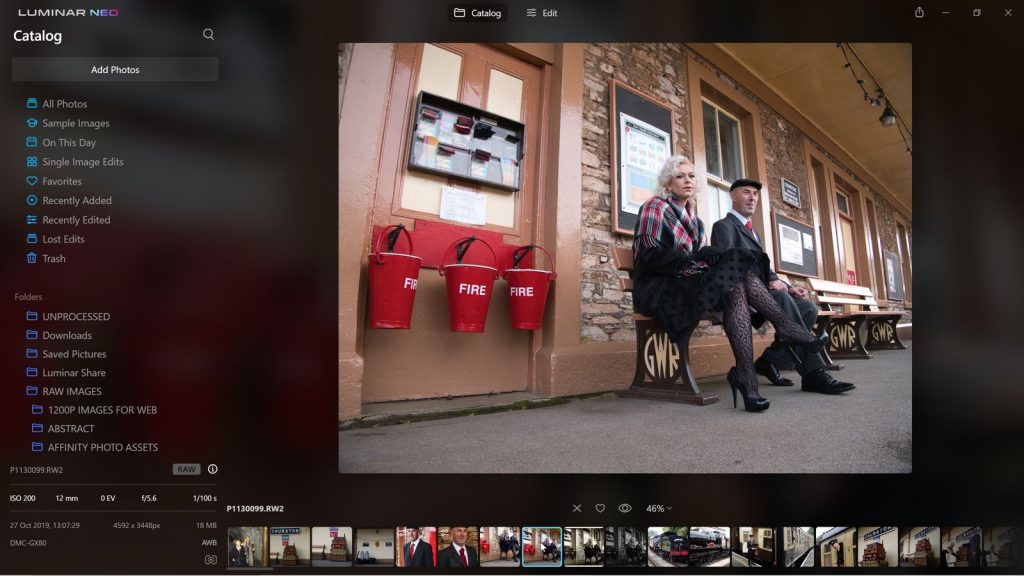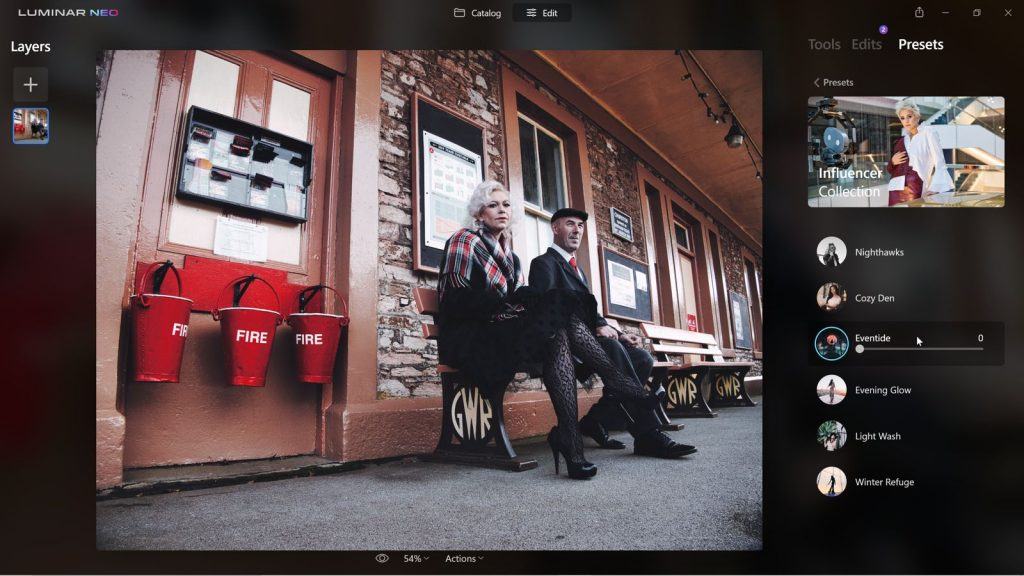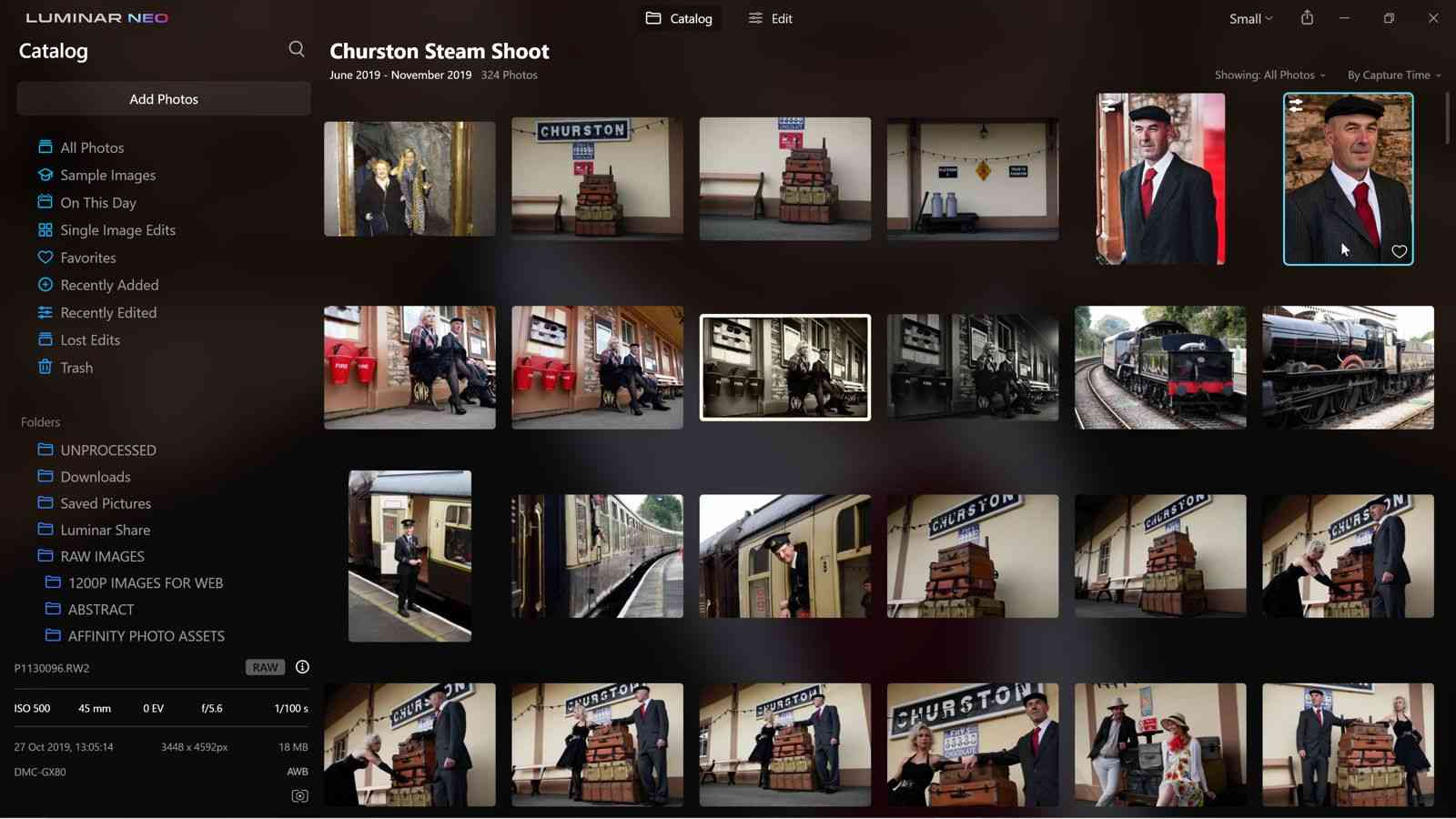Summary
Rather than make you wait for my findings, here’s a summary of how I feel about Luminar Neo after a couple of weeks of using the software. Read on if you want a more in-depth overview.
In my opinion, and this is based on Neo as it stands today, I simply don’t feel that it is ready for prime-time use. There’s simply too much missing in terms of functionality plus its clunky in use and its workflow feels overly complex. Improve the UI, provide it with a usable wokflow, add in some of the key functionality it lacks today and improve performance overall and it could easily overturn this finding, especially if core features like Relight Ai can be improved upon. I fear though that Luminar Neo will need a miracle if its going to compete with the likes of DxO, Lr/Ps, Capture One, On1 PhotoRAW etc within a reasonable timeframe. There’s simply too many issues holding it back and I’m not talking here about features, more the way in which the program works. Yes it can be improved greatly if Skylum listens to it’s customers but they seem to be a company who doesn’t listen or at least they listen but ignore what people are telling them. It’s possible of course that over time my feelings about Neo might change, especially if Skylum work on fixing the huge number of problems this software currently exhibits. When those improvements will come though is anyone’s guess as there are a great number of them needed to remedy the problems with performance and lack of functionality that exists today. Does it do anything well? Yes, as a basic editor it’s very good and inexperienced editors will perhaps be able to overlook its limitations and focus instead on its simplicity and the fact that if you don’t push to to hard, the good results you can achieve. Demand a bit more from it though and you could come unstuck!
Plus Points
- Robust on my Win10 OS and i7 hardware
- Basic but usable catalogue system
- Lot’s of editing tools (that do work) with more promised
- Image layers (but not effects layers as in Luminar 4) and presets included
- Some innovative tools such as Bokah Ai, Relight Ai and Powerline, Dust Bunny removal
- Probably the best sky replacement of any tool out there today
- Share images from a connected mobile device
Negative Points
- Weirdly complicated workflow which is very likely to confuse a lot of users
- Some core tools missing such as clone & stamp, histogram, dodge & burn, over / under exposure indicators
- Very limited portraiture functionality especially when compared with say On1 PhotoRAW 2022
- Can get very slow if you do lots of complex edits which use multiple Ai masks eg Bokah Ai with Relight Ai
- Still no oportunity to create virtual copies
- No perspective adjustment tools provided
- Some users report stability / usability issues especially when opening the software
- Layer feature is very basic – just image layers and not the effects layers as expected
- Some editing functions are very laggy between slider movement and image update
- Overall performance is lack-lustre especially given the marketing hype of an “all new core engine”
- Almost no utilisation of GPU capabilities so heavy on CPU and memory usage
- Presets are rudimentary and slow in operation – 3 seconds or more to apply on my hardware
- Export feature is very hit and miss
- Share works as long as your mobile doesn’t go into sleep mode
Background
To be upfront, I stopped using Skylum software back in early 2020 when various maintenance updates failed to deliver a robust version of Luminar 4. It’s not that I didn’t like Luminar 4, just that it was flaky, especially the DAM. It was also a little “stodgy” and slow in use. This was in contrast to Luminar 3 which I really liked and which was a breath of fresh air in the editing software world. Luminar 3 was cheap, usable and produced excellent results. Given my problems with Luminar 4, when Luminar Ai came along I was not tempted in the least to buy into this “new framework” as by this time I’d moved on to On1 PhotoRAW. Now On1 is not immune to issues but it was a seriously good editor even back then. Two major updates on, and with the inclusion of truly useful features including NonNoise, Resize Ai and Portrait AI and its better than its ever been. So while I was not in the market for a new editor, the marketing hype created by Skylum over the past 6 months is very seductive. It does tend to make you forget about past experiences and to lull you into thinking that maybe Skylum had learned from their mistakes and had finally built a robust, productive and easy to use image editor. Not only that, Skylum know how to press buttons and make you think that you desperately need some unique tool or other that they offer. Besides, the £35 price tag looks cheap when compared to many other editors plus the marketing blurb would have you believe that this software was going to set the photography world on fire. So, having made the investment in Neo do the likes of On1, Capture One, Adobe and others need to worry? Read on and find out.
Ai Technology
Luminar Neo v1.0 is described by Skylum as an advanced photo editor which features core Ai technologies at its heart to help photographers achieve amazing results more quickly than by using more conventional editors. This is because the software is packed with Ai technology. Now to my mind, Ai means machine learning so for example, when I edit a photo the software learns how I edit and what I feel is a good result for particualr images. It can then apply this learning to an image on opening ie a degree of editing has already been undertaken based on previous edits. The more edits I do, the closer the machine gets to creating a perfect edit without any further involvement from me. Skylum do not mean machine learning when it talks about Ai in Luminar Neo. What I think they mean by Ai is that rules are applied to an edit when the slider(s) are moved and that these are relate to such things as exposure, contrast, shadows, highlights, focus etc. This is best demonstrated by taking any image and using the Enhance tool (Accent) to make changes. It’s good, in fact at times the results are excellent, but it’s not true Ai in my opinion.
Version Info
Here I’m using the latest full version which is v1.0.1 which follows swiftly on the heals of pre-release versions v0.9.1 and v0.9.2. These were offered to early bird purchasers in order to enable Skylum to obtain feedback on the functionality, look and feel of Neo. I certainly gave Skylum feedback, both through the app itself as well as in various posts on the Luminar Insiders forum as I assume did many thousands of others. It’s suprising then that the differences between the beta and full release versions were cosmetic for the most part and that many of the tools we expected to be included, clone & stamp, histogram, dodge & burn for example, never made it into this first release. That was somewhat of a surprise as these are basic tools found in practically any editor although since the lead time between beta versions and the full release was only a month, Skylum probably had little time to include these features or indeed fix any performance issues that they were aware of before release. The question I ask myself then is what did Skylum do with all of the customer feedback they received. After all, very little has changed, either in the way Neo works or the way that it looks. I can only assume then that all recent development effort has gone into bug fixes rather than structural change and that sadly seems to be an opportunity missed.

Functionality
With regards Neo functionality, let’s talk first about the catalogue or catalog as they like to call it. It’s the first thing you see when you open Neo and so it’s an important consideration. Again there are no surprises here as it’s looks and works identically to the pre-release versions. Skylum have clearly learnt from their experience with Luminar 4 that DAM technology is not where their strengths lie and that as such, they have opted to deliver a rudimentary catalogue system with minimal but usable functionality. There’s nothing wrong with this, it’s a safe approach and for many users it’s probably enough. However, if you’re used to using Adobe Bridge, On1 PhotoRAW etc than you are likely to be seriously disappointed with the luck of basic functionality especially with regards to EXIF management. Tagging and adding keywords to your image is a core requirement for managing digital assets and its omission is keenly felt by many, myself included. Although I realised quite early when faced with the pre-release versions that this was all we were probably going to get I had hoped that on release we would at least see the option to recurse directories as for me, this makes for a cleaner interface. As it stands, the catalogue system is minimalistic and unremarkable. Its saving grace is that it does at least offer Albums which do make it a little more useful although On1 PhotoRAW 2022 does go one step further by offering Smart Albums which greatly enhance the search system overall. All this being said, cataloging in v1.0, while not blisteringly quick, is more than acceptable and perhaps even a little faster when populating thumbnails than in the pre-release versions. It also works a lot better than on my Luminar 4 system which was one of the key reasons why I left the Skylum family. One obvious thing missing from the catalogue system though is the ability to quickly rate an image. Why Skylum didn’t consider this important on release is anyones guess but your only option here are to set each images as Favourite, Rejected or Unmarked. For most people I suspect this is going to be a disappointment as tagging / colour coding images is really useful. Moving between the Catalog and Edit screens is at least quick so a plus point there.
TOP TIP: You can of course use Luminar Neo with a 3rd party DAM, for example Adobe Bridge or XNviewMP. These offer the ability to do all of the key tasks required to catalogue and document your images while being able to open Luminar Neo to edit a particular Photo. It’s not a seemless approach but it will work.

Editing & Workflow
Moving on, EDIT mode is your next stop. Whereas the catalogue screen is reasonably well laid out, the UI on the Edit screen for me is horrendously poor. It’s as if the two parts of the program have been developed by two teams with the EDIT team all working from home with little or no interaction with other development teams. Whereas the catalogue screen is neet and tidy, with everythng where it should be, albeit you’ll need to click on the Luminar Neo logo to access additional menu functionality, the EDIT panel is in my opinion aweful as you need to scroll up and down the varous tools to find the one you want and that’s messy and unecessary. They ofered a better solution in Luminar 4 so why break something that worked! Now, if you know v0.9.2 then you’re already up to speed on v1.0 albeit that you do now have a Layers panel on the LHS of the screen plus a few extra tools together with some a presets on the RHS of the screen. Tools which have been added now been include Optics (although there is no way to adjust persepctive) and Noise Reduction, which can be found under the very busy Develop tab. In the Layers section you can add your own image layers or choose from any of those provided by Skylum although to my mind, what has been included are practically useless. Skylum for some obscure reason seems to believe that serious photographers want flares, light leaks and sparklers etc when of course what we want to do is to group edits and add textures. You can of course add your own images to layers, textures as mentioned, but it would have been nice if Skylum had included some samples rather then the tacky and completely pointless ones they did. Moving over to the RHS panel confirms, superficially at least, no real changes to what was delivered in the pre-release versions. The Remove Powerlines and Dust Bunny options are still hidden away under the Erase tool as they were in v0.9.2 and nothing new stands out as being hugely different other than the inclusion of a Presets tab. More on this in a moment. In fact, given the lack of any significant improvements to the UI It’s hard to imagine what the development team have been doing between the release of v0.9.2 and v1.0.
Now I mentioned that in this release Skylum had finally delivered Presets. Presets are a quick and easy way to style an image to your liking in a single click. As such they are very handy. No I don’t want to be mean here but in all Luminar versions up to and including 4.3.3 the presets provided were of really good quality and there were a lot to choose from, not only those provided by Skylum but also those from independent creators. In Neo v1.0 you get just three awkwardly presented preset catagories and within these maybe 5 or 6 of presets. On moving through the various presets it’s clear that these offer very little in the way of artistic scope although that view will change from user to user. When preset is applied, and I feel sure that this must be a bug, any edits already applied are deleted in favour of the preset. We have to hope then that there is more to come in the future as presets are powerful tools. As for Layers, it’s clear that Skylum want to monitorise Neo by making users buy additional presets from their store. I noticed that the pricing per preset category was around £15 so this is not a cheap option. I’m not sure given what I have seen in this release that I would be tempted at this price. This aside, the most worrying thing I noticed is that these presets are very laggy in operation and the layout of the presets panel is in my opinion, aweful. You have to scroll across the page to see all of the presets included although thankfully there are only three in this release but imagine having a dozen or so to scroll through!! I’m sure that Skylum can do better than this as it’s not the best use of real-estate. I hate to say it but Luminar 4, despite my dislike of its performance, was much better laid out than Neo. The same goes for the even earlier versions of Luminar 2018 and Luminar 3, which in my opinion were better than later versions of Luminar. I really don’t know where it all went wrong on the UI front but the UI on Neo appears remarkably poor!
Performance
Moving on to editing performance, this is an area that does seem to be worse now than in the pre-release versions. I felt that while slider performance in the v0.9.2 release wasn’t sparkling, it was almost there. In this latest release I feel like I am constantly waiting for the effect to catch up for every edit! On some sliders there was up to a 2 second delay which is nowhere close to being acceptable plus as I mentioned, applying a preset could have you waiting even longer for the effect to show. While I am not using the latest and greatest hardware it is a reasonably snappy i7 with 12BG RAM running under Win10. It also has a dedicated GPU card, which Neo does not access, and a good quality 4K screen. Unlike other editors I choose to use, On1 PhotoRAW 2022 for example, I can’t see any way to optimise the performance of Neo so I’m stuck with what has been delivered. In fact so far the “all new core engine” Skylum promised is turning out to be an underpowered 500cc rather than the 2000cc turbocharged engine they widely promoted.
Tools Provided
With regards to the tools provided, there are a lot of options to choose from and once applied, despite any lag, the results are more than acceptable. These are grouped as essential, creative and professional for the most part. I hate the way they are displayed though as you have to scroll down the screen som way to see them all. MIssing editing tools include dodge & burn, clone & stamp plus access to a histogram with over / under exposure indicators. I would also like to see virtual copies included, this is something many users have been asking for but as yet, Skylum don’t appear to be listening.
Final Views
Well, what can I say here? I am trying really hard to give Skylum the benefit of the doubt with Luminar Neo as I have often been scornful of the self-destructive customer support path they’ve adopted since the launch of Luminar 4 and I feel that they need some praise. It’s not that easy to do so though in this case because for some reason, Skylum choose to introduce completely new products every few years rather than to develop and improve their existing products. Luminar AI is a good example of this strategy, a new product abandoned for the most part after just 18 months. This policy has tended to tarnish their image and alienated them from their customer base. In my case, I had said that Luminar 4.3 was the end game for me as I had moved to On1 PhotoRAW, a decision I don’t regret. I only bought back into the early-bird program for Luminar Neo when I learnt about Relight Ai which I realised could be very valuable if they pulled it off plus it offered an opportunity to see if in Neo they could finally deliver something that was extraordinary. I also want Skylum to succeed, especially as I loved Luminar 2018. Besides, the £35 investment they were looking for was worth the risk in this case as I knew from experience with Luminar 4 that I could use Neo as a plugin to Affinity photo. I also felt that it would be better to be on the inside looking out than wondering what was going on. Skylum wisely created a purchasers only forum which tended to keep bad press away from social media. That has worked to a certain degree but of course, users of Skylum products are generally members of the forum as well as groups on Facebook so bad press tends to leak out regardless.
Do I think then that Skylum has created something special? In truth, almost! On the plus side Neo has been rock solid in use which is something I couldn’t say about Luminar 4 and while there is currently what I would call a basic level of functionality provided, these tools are pretty good and for some users this is probably going to be enough. Sure export is a bit flaky, sometimes it works, sometimes it doesn’t, presets overwrite everything so add them first and then do any additional editing from there onwards and the lag between applying edits and seeing the results is crazy at times. But having said this, the results you get are, well, pretty damn good. For example here we have the original RAW file converted to a jpeg with no processing applied compared to what was achieved using Luminar Neo with the Focus preset, Relight Ai and Bokah Ai applied.


Other Thoughts
Coming from On1 PhotoRAW, Darktable and Affinity though, for me perfomance and real world usage can really only be described as being the bare minimum, particularly as much of the lauded functionallity promised will only be delivered down stream in various updates. All this being said, Neo does provide good results for the most part and it is stable, well for me at least. It is an easy to use editing tool which is going to appeal to photographers who simply want to tidy up an image rather than spend hours editing it. That’s not to say that you can’t do some intricate editing, you can. Just that many users probably won’t want to. Where it might struggle in my opinion is as a tool for professional or commercial photographers where the need to have a fully rounded editor is needed. It will offer some benefits as a plugin though as it does work with Adobe Photoshop and I have got it working with Affinity Photo.

Pingback:Luminar Neo – Two Months Later & Getting Better? – The Creative Camera
Pingback:Luminar Neo – Is it getting there? – The Creative Camera